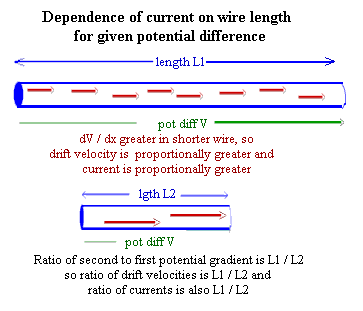
Problem: For a given conducting material at a given temperature, the average drift velocity of the electrons in a uniform wire is directly proportional to the potential gradient, or electric field, present in the wire. (This is related to the fact that the accelerating force on each carrier is q E or q dV /dx, where q is the charge (usually measured in Coulombs) of the carrier and E the electric field (usually measured in N / C). The temperature of the wire affects the drift velocity at any given potential gradient.).
If the current in a certain uniform wire of length .5000 meters is 39 amps when a certain potential difference is maintained across the wire, then what will be the current in a 3.5- meter length of otherwise identical wire, at the same temperature as the first, with the same potential difference?
.
.
.
.
.
.
.
.
.
.
.
.
.
.
.
.
.
.
.
.
.
.
.
.
.
.
.
.
.
.
Solution: The potential difference is not given, so call it V. The electric field or potential gradient in the first wire is V / .5000 m; in the second wire it is V / 3.5 m. The potential gradient in the second wire is therefore (V / 3.5) / (V / .5000) = .5000 / 3.5 = 7 times that in the first.
It follows that the drift velocity of the electrons in the second wire is 7 times that in the first. The wires are identical: except for length they each have the same number of current carriers available per unit length. So the current, or the rate at which charges pass a point in the second wire, is 7 times that in the first. The current in the second wire is therefore 7 * 39 = 273 charges / second.
Generalized Response: If the same potential difference V is maintained across two uniform wires of lengths L1 and L2, identical except for length, then the ratio of the second to the first potential gradient is (V / L2) / (V / L1) = L1 / L2. The ratio of drift velocities will therefore be L1 / L2. Since equal numbers of charge carriers are available per unit length, the ratio of currents will be L1 / L2.
.
.
.
.
.
.
.
.
.
.
Figure description: The figure below shows two wires of different lengths with the same potential difference V between their ends. The potential gradient E = dV / dx is greater in the shorter wire, so the drift velocity is higher. The higher drift velocity implies a proportionally higher current.